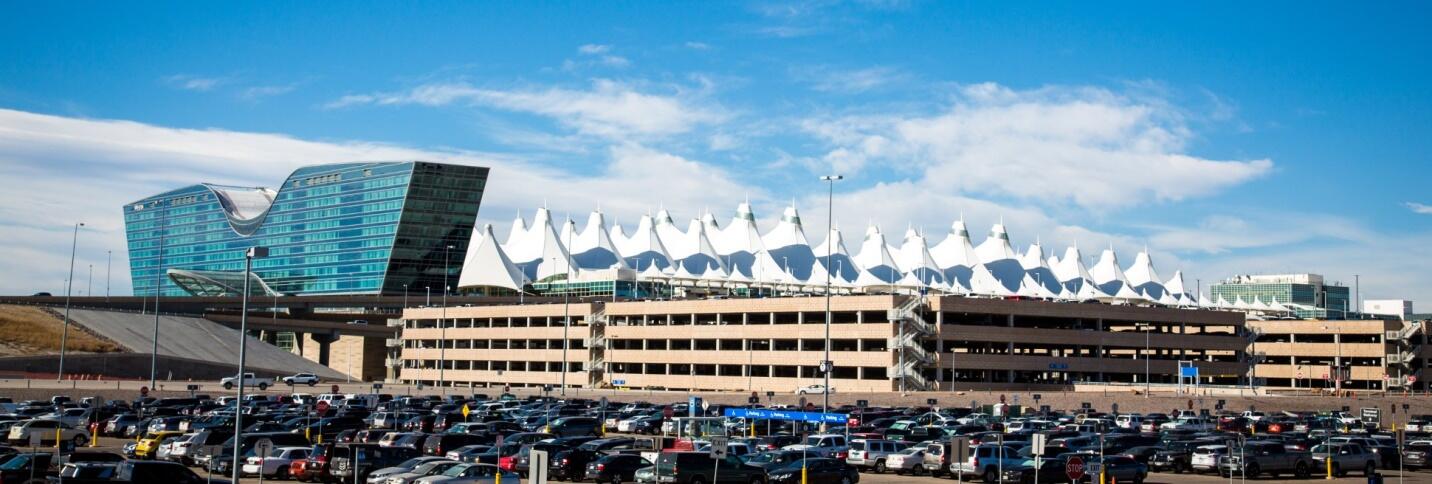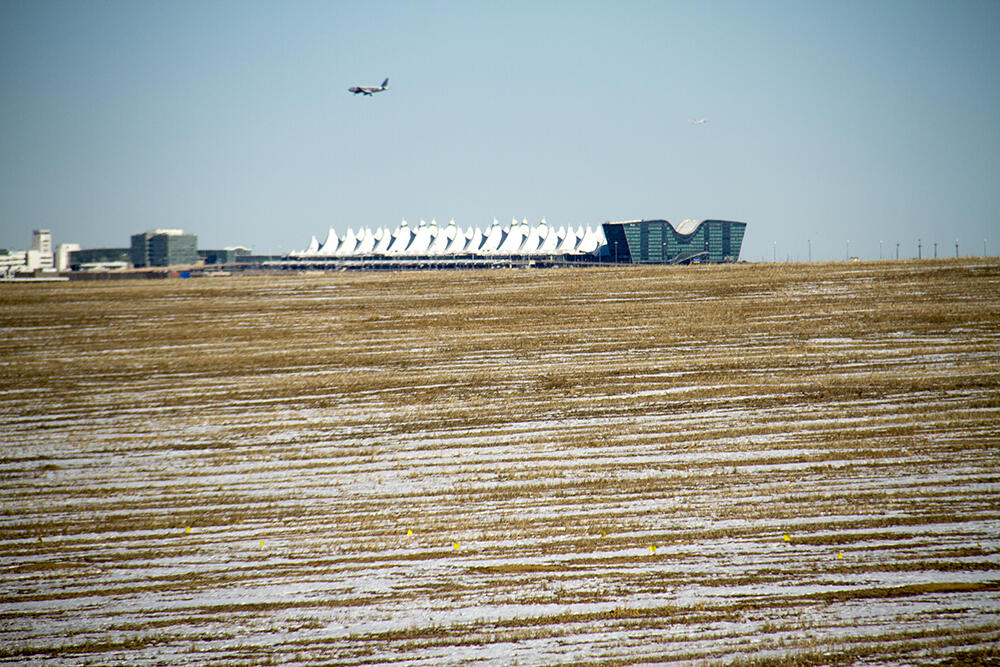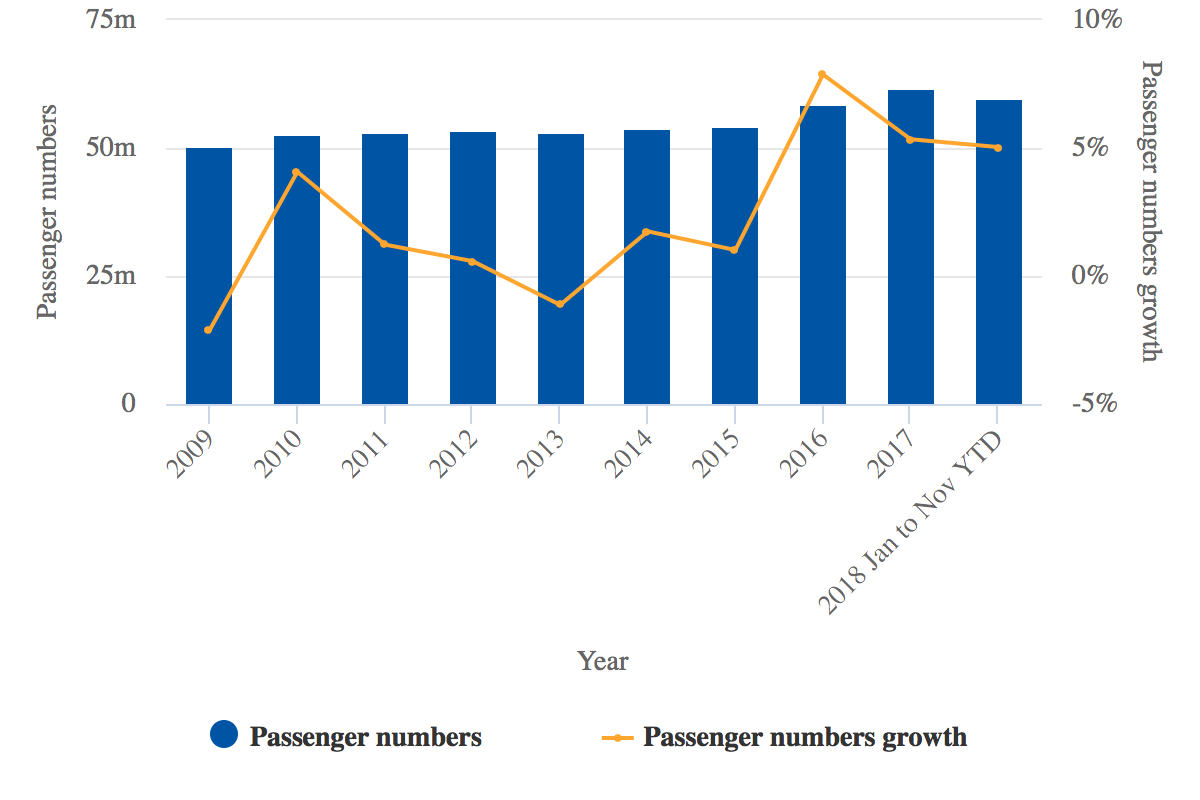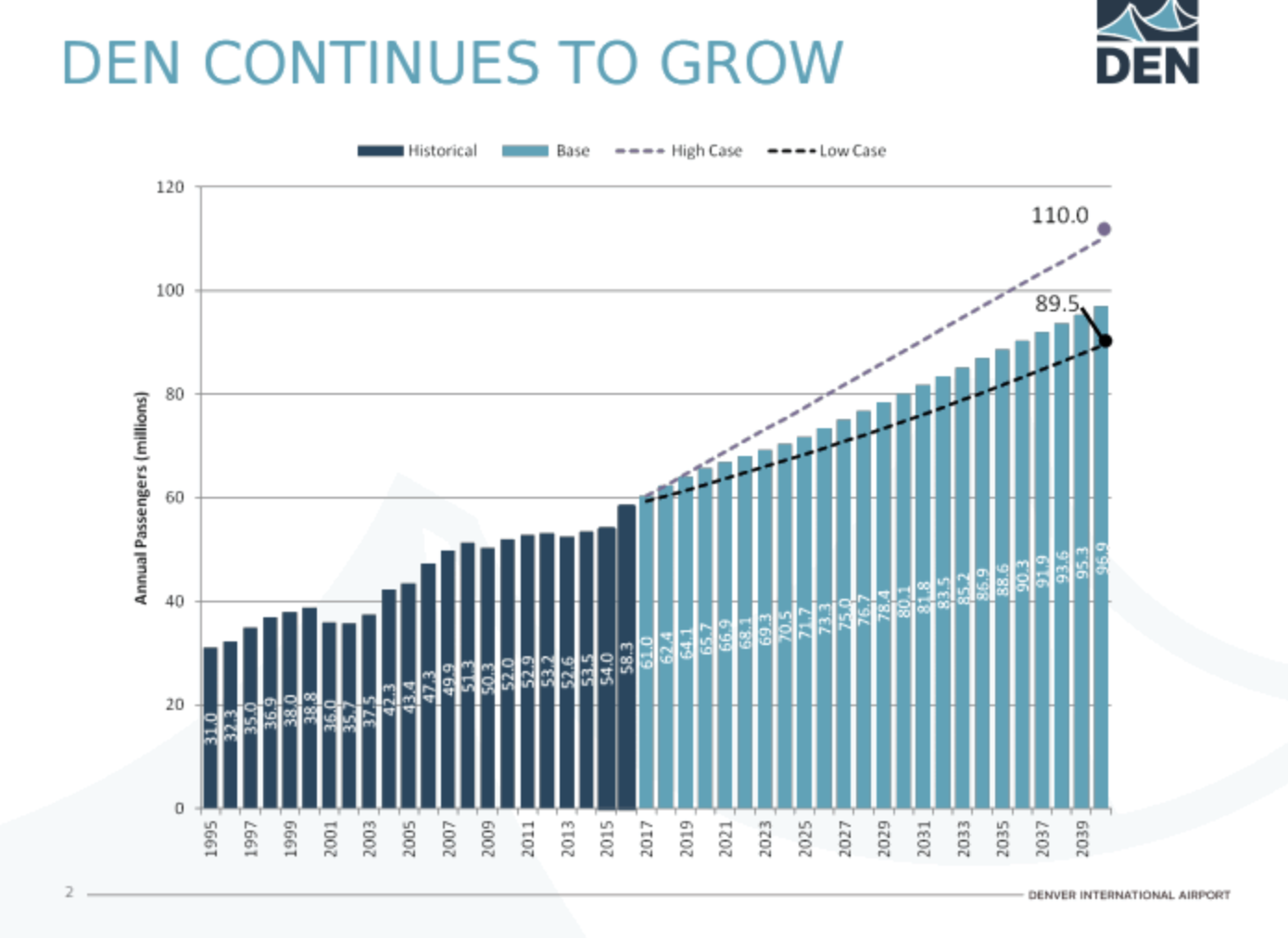Description of the Airport, Its Owner, Region Served, and Airlines Using It
Denver International Airport was founded in 1995 to serve the metropolitan of Denver in Colorado and the larger Front Range Urban Corridor (Jaffe, 2014). The airport is also used frequently by international airlines. The County and City of Denver own the airport, and the county’s department of aviation is in charge of its operations. According to Ohlandt (2017), it is the second-largest airport in the world and the largest airport in North America in terms of the total land covered.
Ventura (2015) reports that the airport is the fifth busiest one in North America after O’Hare in Chicago, Hartsfield-Jackson in Atlanta, the Los Angeles Airport, and Dallas-Fort Worth Airport (Grant, 2016). Frontier Airlines and United Airlines are the main domestic airlines serving this city. Other major international airlines that use this airport regularly include British Airways, Lufthansa, British Airways, JetBlue, Delta Airlines, and American Airlines. Figure 1 below shows the architectural design of Denver International Airport.

Agencies Responsible for Providing Security at the Airport
The management of this airport is keen on ensuring that the security of passengers and cargo is guaranteed, especially at a time when the threat of terrorist attack is becoming a major issue in the aviation sector. The airport has contracted three main private security agencies to ensure that the facility is safe for all its users. Denver Security Services is the main security agency responsible for general security and screening at this airport.
It subcontracted some of these responsibilities to True Security Inc (Grant, 2016). Advanced Professional Security is another agency that is primarily responsible for cybersecurity at this airport. It works throughout the day and night to ensure that cybercriminals do not gain access to the firm’s database.
Protect the Airspace, Proper Land Uses, Runway Use Preferences, and Noise Management
The security of planes goes beyond the threat of criminal or terror attacks within the airport or in the planes. Ventura (2015) explains that obstructions are another major concern that the management of the airport, through relevant government authorities, must address effectively. The Federal Aviation Authority (FAA) issues Advisory Circular 70/7460-1L that defines lighting at local airports and how to eliminate any obstruction that can affect it.
Part 77 of the Code of Federal Regulation (CFR) requires all structures near the airport which are 200 feet above ground level (AGL) to get approval from local authorities before undertaking any modification (Ventura, 2015). The code also considers any structure 499 above ground level an obstruction. The county government does not restrict private citizens from constructing private residential units in the private land adjacent to the airport.
However, it encourages having business offices, warehouses, and related activities as a way of reducing the impact of noise from planes on young children and the elderly. The two airlines using this airport as its hub, Frontier Airline, and United Airlines, may have a strategic advantage over its rivals in terms of cost of operation, but all local airlines are given runway use preferences as a way of growing the domestic aviation sector and transforming this airport into one of the busiest in the region. The management of the airport designed the approach and departure paths on the section of the land furthest from the residential areas to reduce the impact of aircraft noise on the surrounding communities. Figure 2 below shows land use within the airport.

Government Agency or Authority That Took Such Actions
Various government agencies have been working together to ensure that this airport is a success and does not pose any significant threat to the local community. The Federal Aviation Authority, working closely with Denver City Council, has the responsibility of ensuring that there are no obstructions within the airport and its immediate surroundings. These authorities work closely with the International Civil Aviation Organization to ensure that international best practices are embraced in the city in terms of eliminating the obstruction and protecting local residents from excessive noise pollution. They regulate any structure that is put up within and in the immediate surroundings of the airport.
Denver City Council has the mandate of ensuring that land use in areas close to their airport follows the standards set by various agencies. It regulates the nature of the structures and their use. The government created the Council on Environmental Quality (CEQ) as the body responsible for environmental impact assessment in the country (Delray, 2017). This government agency ensures that any construction work around the airport has a clean bill of health in terms of its impact on the immediate environment and the manner in which its users will be affected by the noise from aircraft.
As shown in figure 3 below, a large parcel of land within the vicinity of their airport is not used just to ensure that the local community is protected from noise pollution, as this agency requires. These agencies and government authorities have to work together to ensure that the interest of the local community and that of the airport, the airlines, and all its users are protected.

Source and Type of Government Legal Powers Relied on to Accomplish these Actions
The legal powers that the government has to accomplish the actions discussed above are enshrined in various legislations. According to Grant (2016), the primary legislation that governs the domestic aviation industry is the Federal Aviation Act of 1958. When President Dwight Eisenhower signed it into law, the Civil Aeronautics Administration (CAA) was abolished, and in its place, the Federal Aviation Authority was created. The authority was mandated to regulate all activities relating to the management and regulation of aviation activities in the country. The Act is the source of power to all the regulatory actions taken by the FAA and other entities working under it.
The National Environmental Policy Act (NEPA) of 1969 led to the creation of the Council on Environmental Quality (CEQ). It is important to note that although this council is not primarily focused on regulating activities in the aviation sector, it is the agency responsible for ensuring that constructions are approved based on set environmental standards. On the one hand, it seeks to ensure that structures, such as the airport itself and buildings around it, do not pose any significant threat to the environment and ecosystem.
On the other hand, it ensures that the immediate environment cannot adversely affect a new structure that is put up in a given location. For instance, it is less likely that the agency would approve the construction of a school or hospital close to the airport. Such institutions may not have an adverse effect on the normal operations of the airport, but the noise from the airplanes landing or taking off at the airport may be unbearable to patients and young learners.
Denver Comprehensive Plan 2000 is an integrated land use and transportation plan that seeks to ensure that there is proper zoning within the city (Ventura, 2015). In this plan, there is a deliberate attempt to ensure that institutions such as hospitals and schools are located as close to the residential areas as possible. On the other hand, the industrial sector has to be on the other side of the city where its pollutants would have the least possible impact on residents.
The road network is designed in a way that ensures that people can move from work to their homes and schools and back with ease. Denver International Airport is integrated within this plan, in a section closer to the industrial sector than to the residential sector. The goal, as was environed in this zoning plan, was to ensure that people are least affected by the noise of planes landing or taking off from the airport.
All Airline Accidents At or Near the Airport since 1/01/2000 and the Probable Cause of Each
Denver International Airport, just like many other airports around the world, has experienced cases of an accident that tainted its image in one way or the other in the international market. On September 5, 2001, British Airways’ Boeing 777 caught fire during the refueling procedure (Grant, 2016). One person, the person who was refueling the jet, died of the injuries sustained from the accident six days after the incident.
All the passengers and crew members were safely evacuated from the plane and were not injured. The investigation revealed that the accident was caused by a failure of the plane’s refueling ring, which was unable to hold the fuel horse at the right angle, leading to the rapture (Ventura, 2015). The immediate action of the fire department at the airport helped prevent further fatalities or injuries of various persons and the destruction of properties around the airport.
The incident that happened on February 16, 2007, at Denver International Airport had a major implication about the quality of service offered at this institution. It is reported that within three and a half hours, 14 airplanes suffered windshield malfunctions at the airport (Grant, 2016). It was reported that 26 windshields of the 14 aircraft failed to function as expected. There were no injuries or further damage to the planes because of the incident, but it caused major concern to the country’s aviation sector. The National Transport and Safety Board (NTSB) conducted an investigation, which revealed that the incident was caused by foreign object damage.
The investigation revealed that sharp sand that had been used for purposes of traction that winter was carried by wind moving at 77 km/h (48 mph) onto the windshields, causing the failure. The issue was resolved, and further recommendations were given on how to avoid similar incidences in the future.
On December 20, 2008, Continental Airlines Flight 1404, using Boeing 737-500 destined to Houston-Intercontinental Airport, veered off runway 34R at Denver International Airport, catching fire in the process during a takeoff roll (Grant, 2016). Two people were critically injured, while another 38 sustained different levels of injuries of the 115 people who were on board the plane. There were no fatalities. However, the aircraft was damaged, and another plane had to be used to ensure that passengers reach their destination.
The investigation by NTSB revealed that although the runway had no snow, the crosswinds were moving at a speed of 31-knots, which required the pilot to use the right rudder input to maintain the control by countering the pressure (Ventura, 2015). However, the pilot failed to make that input, which led to the incident. The investigators recommended further training for pilots to enable them to deal with crosswinds more effectively.
On April 3, 2012, ExpressJet Embraer Flight UA/EV-5912, which was coming from Peoria, Illinois to Denver, landed on 34R, and the plane hit the approach lights (Grant, 2016). The aircraft came to a sudden stop after hitting the lights, and the engines caught fire. The cockpit and fuselage were engulfed in smoke. However, the emergency response team arrived in time to evacuate everyone on board the plane (Ohlandt, 2017). The fire was put out before it could cause further damage to the aircraft or other structures along the runway. There were no fatalities in this accident, but one passenger was taken to the hospital for further medication because of the injuries he sustained during the accident.
The captain reported that they had detected active fire just before landing. The National Transport and Safety Board conducted an investigation, which revealed that the accident was primarily caused by landing the plane before the runway threshold (Ventura, 2015). It was established that the crewmembers were under pressure to land the aircraft before the fire could spread further and intensify. A leakage in the nose gear was identified as the cause of the smoke.
Recently on July 2, 2017, SkyWest Flight 5869 caught fire soon after landing at Denver International Airport from Aspen (Ohlandt, 2017). The investigations revealed was a foreign object was on the left engine that developed a technical problem before catching fire.
However, the investigators were not able to ascertain whether the object entered the engines at the Aspen Airport or when the plane hit the runways of Denver International Airport. However, the investigators recommended that there should be a regular inspection of the runways to eliminate any foreign objects, which may pose security risks to airplanes. All the 63 people (59 passengers and 4 crew members) on board were safely evacuated from the aircraft. The fire department responded quickly and helped stop the fire before the aircraft could be damaged further.
Current Noise and Safety Issues of Concern to the Community, and Ways of Addressing Them
Denver International Airport has been keen on regulating noise pollution as one of its corporate social responsibilities to the immediate community living around the facility. The current noise pollution primarily comes from aircraft. As Grant (2016) observes, managing noise from airplanes is beyond the control of airport authorities. In the United States of America, the FAA has been working closely with aircraft manufacturers to ensure that new planes have quieter engines to make them environmentally friendly.
The authority has developed different stages of noise pollution from aircraft. For helicopters, there is stage one, which is the loudest, then stage 2, and finally stage three, which is a significantly silent engine. For civil aircraft, there are stages 1 and 2, with stage 2 being a less loud engine than stage 1. The goal is to phase out the stage 1 engine known to produce the loudest noise.
The management unit of this airport has made significant steps in improving the safety of passengers, cargo, and aircraft within this facility. Employees working in the emergency and rescue unit have been taken through thorough training to ensure that they know how and when to respond to different emergencies. The introduction of modern technologies for managing fire and other emergencies also makes this airport one of the safest in the world (Ohlandt, 2017). However, the main safety issue that is still a major cause of concern is the expertise of the crewmembers of the airlines using this airport and the soundness of these aircraft.
As shown in the discussion above, all accidents and incidents that have happened in this airport since 2000 were caused by pilot or engine error, except one. The airlines have to ensure that their planes are mechanically sound and that their crewmembers understand how to maneuver their aircraft. Software error, such as that witnessed in Boeing 737 MAX, is also another major concern that the manufacturer should address to avoid accidents similar to that of Ethiopian Airlines Flight 302 and Lion Air Flight 610 (Ventura, 2015). Most of these issues are beyond the control of the management of this airport.
Airport’s Level of Activity and Forecast Air Traffic Demand
Denver International Airport is one of the fastest-growing airports in North America in terms of the number of passengers using it per year. As shown in figure 4 below, there has been a consistent increase in the number of passengers using the facility from 2009 to 2018. The 2008 economic recession had a significant impact on its growth, but it recovered, and the growth is expected to continue in the coming years.

The growing local and international economies will push up the demand for air transport services. As Grant (2016) notes, the air traffic demand appears sustainable because of globalization, and the strategic location of Denver International Airport makes it easy for it to take full advantage of the opportunity. The threat of terror attacks may be a concern, but measures put in place by the government and private players have improved security in this sector. Figure 5 below shows the projected growth at Denver airport.

The projection shows that there will be an increase in both the number of passengers and the number of goods passing through this airport. The increase in the purchasing power of individuals in the United States makes it possible for them to afford air travel. Besides domestic travels, a significant population of Americans flies out of the country for business and as tourists to different countries around the world.
The number of foreigners coming to this country is also increasing, and most of them come through air transport (Delray, 2017). Increased trade between the United States and the European Union, Japan, China, and Africa is also responsible for the projected growth of the airport. However, the management must ensure that it improves the capacity of the airport as the demand for its services continues to rise.
References
Delray, S. (2017). DIA: One night at the Denver International Airport. Garibaldi Highlands, BC: eXtasy Books.
Grant, R.M. (2016). Contemporary strategy analysis: Text and cases. Chichester, UK: Wiley Publishers.
Jaffe, E. (2014). A curious madness: An American combat psychiatrist, a Japanese war crimes suspect, and an unsolved mystery for World War III. New York, NY: Simon & Schuster Publishing Company.
Ohlandt, C.J. (2017). Chinese investment in U.S. aviation. Santa Monica, CA: RAND Corporation.
Szyliowicz, J.S., & Zamparini, L. (Eds.). (2018). Air transport security: issues, challenges and national policies. Cheltenham, UK: Edward Elgar Publishing.
Ventura, J. (2015). American conspiracies. New York, NY: Simon & Schuster Publishing Company.